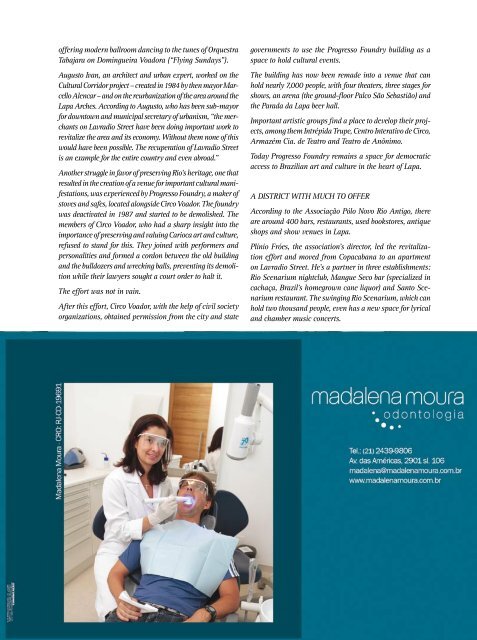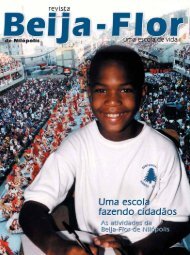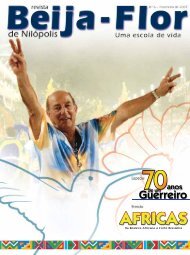VIDA SÓ VALE SE FOR POR PRAZER - GRES Beija-Flor de Nilópolis
VIDA SÓ VALE SE FOR POR PRAZER - GRES Beija-Flor de Nilópolis
VIDA SÓ VALE SE FOR POR PRAZER - GRES Beija-Flor de Nilópolis
You also want an ePaper? Increase the reach of your titles
YUMPU automatically turns print PDFs into web optimized ePapers that Google loves.
offering mo<strong>de</strong>rn ballroom dancing to the tunes of Orquestra<br />
Tabajara on Domingueira Voadora (“Flying Sundays”).<br />
Augusto Ivan, an architect and urban expert, worked on the<br />
Cultural Corridor project – created in 1984 by then mayor Marcello<br />
Alencar – and on the reurbanization of the area around the<br />
Lapa Arches. According to Augusto, who has been sub-mayor<br />
for downtown and municipal secretary of urbanism, “the merchants<br />
on Lavradio Street have been doing important work to<br />
revitalize the area and its economy. Without them none of this<br />
would have been possible. The recuperation of Lavradio Street<br />
is an example for the entire country and even abroad.”<br />
Another struggle in favor of preserving Rio’s heritage, one that<br />
resulted in the creation of a venue for important cultural manifestations,<br />
was experienced by Progresso Foundry, a maker of<br />
stoves and safes, located alongsi<strong>de</strong> Circo Voador. The foundry<br />
was <strong>de</strong>activated in 1987 and started to be <strong>de</strong>molished. The<br />
members of Circo Voador, who had a sharp insight into the<br />
importance of preserving and valuing Carioca art and culture,<br />
refused to stand for this. They joined with performers and<br />
personalities and formed a cordon between the old building<br />
and the bulldozers and wrecking balls, preventing its <strong>de</strong>molition<br />
while their lawyers sought a court or<strong>de</strong>r to halt it.<br />
The effort was not in vain.<br />
After this effort, Circo Voador, with the help of civil society<br />
organizations, obtained permission from the city and state<br />
governments to use the Progresso Foundry building as a<br />
space to hold cultural events.<br />
The building has now been rema<strong>de</strong> into a venue that can<br />
hold nearly 7,000 people, with four theaters, three stages for<br />
shows, an arena (the ground-floor Palco São Sebastião) and<br />
the Parada da Lapa beer hall.<br />
Important artistic groups find a place to <strong>de</strong>velop their projects,<br />
among them Intrépida Trupe, Centro Interativo <strong>de</strong> Circo,<br />
Armazém Cia. <strong>de</strong> Teatro and Teatro <strong>de</strong> Anônimo.<br />
Today Progresso Foundry remains a space for <strong>de</strong>mocratic<br />
access to Brazilian art and culture in the heart of Lapa.<br />
A DISTRICT WITH MUCH TO OFFER<br />
According to the Associação Pólo Novo Rio Antigo, there<br />
are around 400 bars, restaurants, used bookstores, antique<br />
shops and show venues in Lapa.<br />
Plínio Fróes, the association’s director, led the revitalization<br />
effort and moved from Copacabana to an apartment<br />
on Lavradio Street. He’s a partner in three establishments:<br />
Rio Scenarium nightclub, Mangue Seco bar (specialized in<br />
cachaça, Brazil’s homegrown cane liquor) and Santo Scenarium<br />
restaurant. The swinging Rio Scenarium, which can<br />
hold two thousand people, even has a new space for lyrical<br />
and chamber music concerts.<br />
Fevereiro 2010






